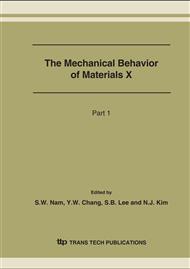p.457
p.461
p.465
p.469
p.473
p.477
p.481
p.485
p.489
Fatigue Crack Growth Behavior of a Gas Pressure Welded Part of Rail Steel under Mixed Mode Loading
Abstract:
The transverse crack, which is the most dangerous damage among the various types of rail defects, is developed from shelling near the rail running face, and grows perpendicular to the rail surface. Therefore, to assure the safety of rolling stocks, it is necessary to investigate the fatigue crack growth behavior of a gas pressure welded part of rail steel under mode I and mixed mode loadings. In this study, the fatigue crack growth behavior under the mixed mode was discussed by using comparative stress intensity factor ranges proposed by Richard. In addition, to evaluate the effect of the crack closure quantitatively, the crack opening load was determined a using clip-on gauge and computerized image processing system. As a result of this, a mixed mode crack growth rate regardless of the stress ratio could be correlated with the effective comparative stress intensity factor ranges derived from the crack opening loading.
Info:
Periodical:
Pages:
473-476
Citation:
Online since:
August 2007
Authors:
Price:
Сopyright:
© 2007 Trans Tech Publications Ltd. All Rights Reserved
Share:
Citation:


